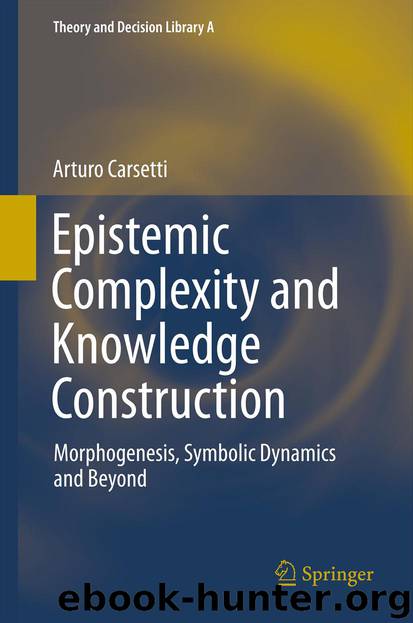Epistemic Complexity and Knowledge Construction by A. Carsetti

Author:A. Carsetti
Language: eng
Format: epub
Publisher: Springer Netherlands, Dordrecht
a ≠ S0
a ≠ SS0
…
It is easy to show that the infinite set of axioms of N 1* will be consistent if N 1 is consistent. Now, by Gödel’s incompleteness theorem, any consistent set of first-order formulas has a model. But, the intended interpretation of N 1 in the natural numbers cannot be a model of N 1*. Actually, any model Q of N 1* must be a model of N 1 and, at the same time, a model of the new formulas a ≠ 0, a ≠ S0, a ≠ SS0. Therefore, the universe of Q contains non-standard numbers.
We know that for every infinite cardinal, there are at least 2ℵ ° non-isomorphic models of N 1 of that cardinality. Those models of N 1 that are isomorphic with the intended model of N 1 are its standard models. All other models are non-standard models.
Now, let us imagine building a particular extension of our non-standard model of the first-order theory of natural numbers, Q, that is a second-order structure capable of presenting itself as a model of N 2. Let us call this structure Q′. It is easy to show that if the structure Q′ were, as required, a model of N 2, it must be non-standard in the second-order sense: i.e., such that each D n ⊆ P D n and D m ≠ P D m for at least one m ≥ 1. Actually, in the universe of Q′ there are non-standard numbers. This means that the set of standard numbers is not in the universe of unary relations of Q′. Thus, the structure Q′ is non-standard in the second-order sense.
When we are in second-order logic, but we make essential reference to non-standard interpretations and allow structures with non-full relational universes, quantification only applies for the sets and relations that are present in the structure. In the general structures of Henkin, for instance, we put in the universes all sets and relations that are parametrically definable in the structure by second-order formulas. In this sense, it is not surprising that the set of standard numbers is not definable by a second-order formula in a structure having non-standard numbers. If we indicate with P. Def. (Ψ, L′) the set of all parametrically Ψ -definable relations on individuals using the language L′, we can say directly that a given frame Ψ is a general structure iff D n = P D n ∩ P. Def. (Ψ, L′).
What is important to stress again is the fact that hidden within the structure some specific relations exist, some “rules” (second-order relations) that cannot be defined as relations among individuals, but are utilized to define first-order relations (i.e., relations among individuals). As a result, we obtain a particular structure where the n-ary relation universe is a proper subset of the power set of the n-ary Cartesian product of the universe of individuals. So, whereas in the standard structures the notion of subset is fixed and an n-ary relation variable refers to any n-ary relation on the universe of individuals, in the non-standard structures, on the contrary, the notion of subset is explicitly given with respect to each model.
Download
This site does not store any files on its server. We only index and link to content provided by other sites. Please contact the content providers to delete copyright contents if any and email us, we'll remove relevant links or contents immediately.
Algorithms of the Intelligent Web by Haralambos Marmanis;Dmitry Babenko(16235)
Jquery UI in Action : Master the concepts Of Jquery UI: A Step By Step Approach by ANMOL GOYAL(9387)
Test-Driven Development with Java by Alan Mellor(7735)
Data Augmentation with Python by Duc Haba(7609)
Principles of Data Fabric by Sonia Mezzetta(7378)
Learn Blender Simulations the Right Way by Stephen Pearson(7294)
Microservices with Spring Boot 3 and Spring Cloud by Magnus Larsson(7137)
Hadoop in Practice by Alex Holmes(6588)
RPA Solution Architect's Handbook by Sachin Sahgal(6517)
The Infinite Retina by Robert Scoble Irena Cronin(6216)
Big Data Analysis with Python by Ivan Marin(5934)
Life 3.0: Being Human in the Age of Artificial Intelligence by Tegmark Max(5518)
Pretrain Vision and Large Language Models in Python by Emily Webber(4894)
Infrastructure as Code for Beginners by Russ McKendrick(4653)
Functional Programming in JavaScript by Mantyla Dan(4436)
WordPress Plugin Development Cookbook by Yannick Lefebvre(4382)
The Age of Surveillance Capitalism by Shoshana Zuboff(4248)
Embracing Microservices Design by Ovais Mehboob Ahmed Khan Nabil Siddiqui and Timothy Oleson(4148)
Applied Machine Learning for Healthcare and Life Sciences Using AWS by Ujjwal Ratan(4135)
